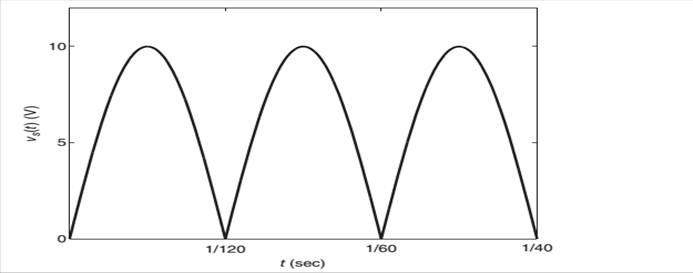
Concept explainers
The expression for the steady state voltage vo (t)for a full wave rectifier.
The steady stat response for the given fullwave rectifier is given by,

Given: The sinusoidal voltage waveform of a fullwave rectifier

FigureP9.31
Fourier series approximation and is given by
Fourier series approximation = vs (t) = 
Transfer function =  Where R = 600
Where R = 600  and C
and C 
Concept Used:
We first calculate  magnitude of the given transfer function, phase angle, bandwidth and magnitude of phase angles of respective frequencies and finally calculate the expression for steady state response of the full wave rectifier.
magnitude of the given transfer function, phase angle, bandwidth and magnitude of phase angles of respective frequencies and finally calculate the expression for steady state response of the full wave rectifier.
Calculation:
The Fourier series approximation is given by,
vs (t) = 
The transfer function of series RC circuit is given by,

The expression for magnitude of transfer function of the given full wave rectifier is
 (1)
(1)
Substituting for R = 600  and C
and C  in equation (1) we get,
in equation (1) we get,

 (2)
(2)
The phase angle for the given fullwave rectifier is given by
 .... (3)
.... (3)
Substituting for R = 600  and C
and C  in equation (3) we get,
in equation (3) we get,

 .... (4)
.... (4)
The bandwidth  for the given system should lie between 0 and
for the given system should lie between 0 and 

 (5)
(5)
Substituting for R = 600  and C
and C  in equation (5) we get,
in equation (5) we get,

 1666.67 rad/s
1666.67 rad/s
As  is greater than 1666.67 rad/s which is outside the required bandwidth, we consider only 0, 240
is greater than 1666.67 rad/s which is outside the required bandwidth, we consider only 0, 240  and 480
and 480  only for frequency values.
only for frequency values.
The magnitude value for the frequencies 0, 240  and 480
and 480  is,
is,
From equation (2) we know that

Substituting for  0, 240
0, 240  and 480
and 480  respectively we get
respectively we get

 (6)
(6)

On simplifying we get
 0.9111.... (7)
0.9111.... (7)

On simplifying we get
 (8)
(8)
From equation (4) we have 
Now calculating the phase angles for corresponding frequencies 0, 240  and 480
and 480  respectively we get,
respectively we get,








The steady state voltage for the given full-wave rectifier with Fourier series,
vs (t  is given by
is given by



Conclusion:
Therefore, the steady state response for the given fullwave rectifier is given by,

Want to see the full answer?
Check out a sample textbook solution
Chapter 9 Solutions
System Dynamics
 Elements Of ElectromagneticsMechanical EngineeringISBN:9780190698614Author:Sadiku, Matthew N. O.Publisher:Oxford University Press
Elements Of ElectromagneticsMechanical EngineeringISBN:9780190698614Author:Sadiku, Matthew N. O.Publisher:Oxford University Press Mechanics of Materials (10th Edition)Mechanical EngineeringISBN:9780134319650Author:Russell C. HibbelerPublisher:PEARSON
Mechanics of Materials (10th Edition)Mechanical EngineeringISBN:9780134319650Author:Russell C. HibbelerPublisher:PEARSON Thermodynamics: An Engineering ApproachMechanical EngineeringISBN:9781259822674Author:Yunus A. Cengel Dr., Michael A. BolesPublisher:McGraw-Hill Education
Thermodynamics: An Engineering ApproachMechanical EngineeringISBN:9781259822674Author:Yunus A. Cengel Dr., Michael A. BolesPublisher:McGraw-Hill Education Control Systems EngineeringMechanical EngineeringISBN:9781118170519Author:Norman S. NisePublisher:WILEY
Control Systems EngineeringMechanical EngineeringISBN:9781118170519Author:Norman S. NisePublisher:WILEY Mechanics of Materials (MindTap Course List)Mechanical EngineeringISBN:9781337093347Author:Barry J. Goodno, James M. GerePublisher:Cengage Learning
Mechanics of Materials (MindTap Course List)Mechanical EngineeringISBN:9781337093347Author:Barry J. Goodno, James M. GerePublisher:Cengage Learning Engineering Mechanics: StaticsMechanical EngineeringISBN:9781118807330Author:James L. Meriam, L. G. Kraige, J. N. BoltonPublisher:WILEY
Engineering Mechanics: StaticsMechanical EngineeringISBN:9781118807330Author:James L. Meriam, L. G. Kraige, J. N. BoltonPublisher:WILEY





